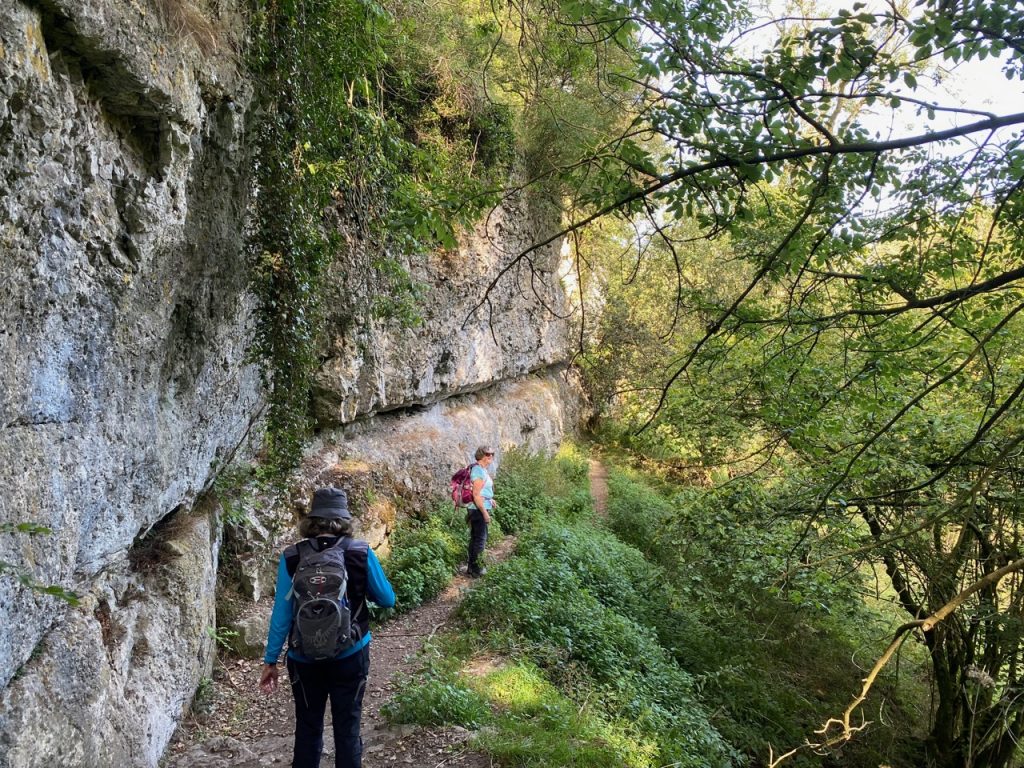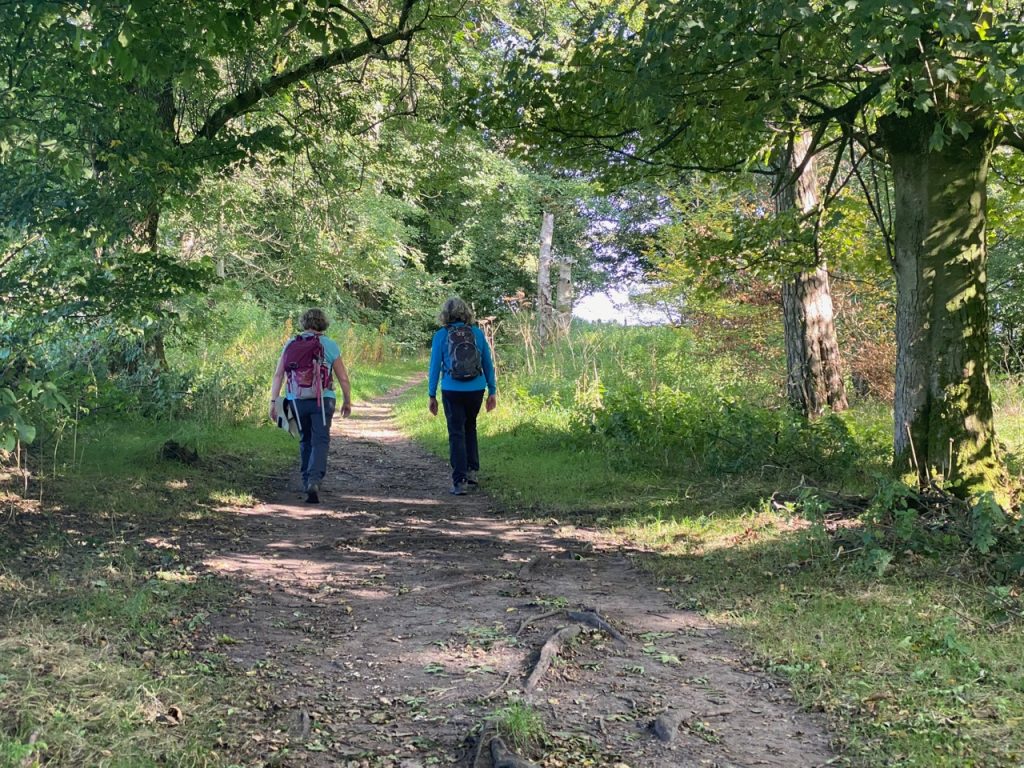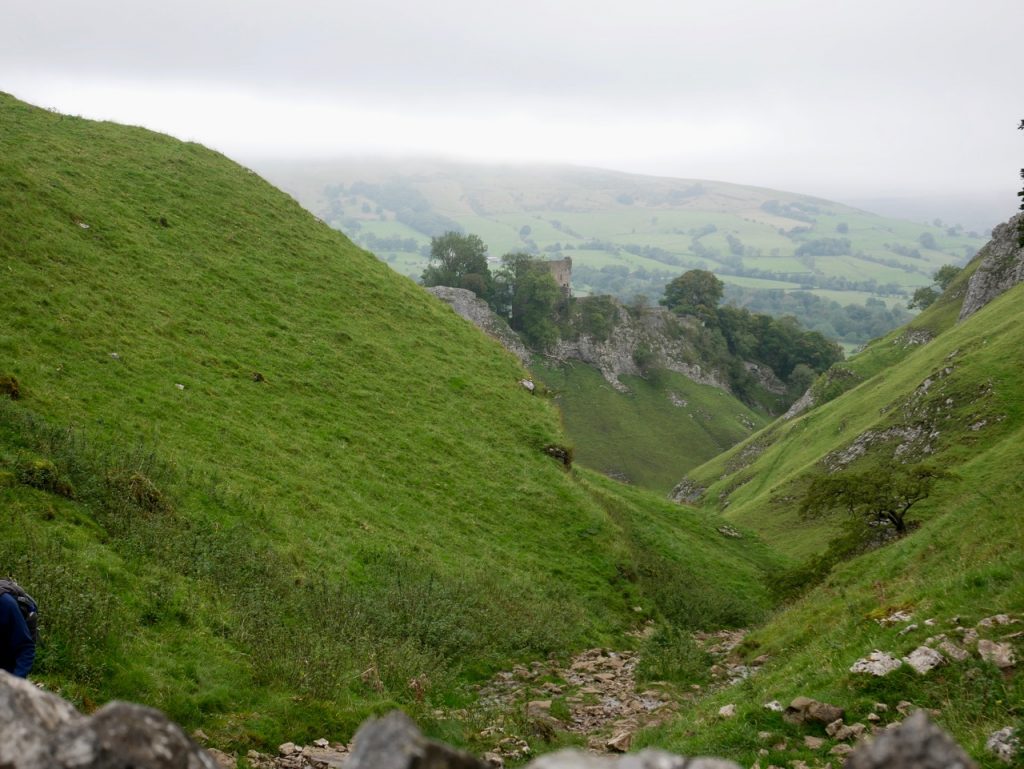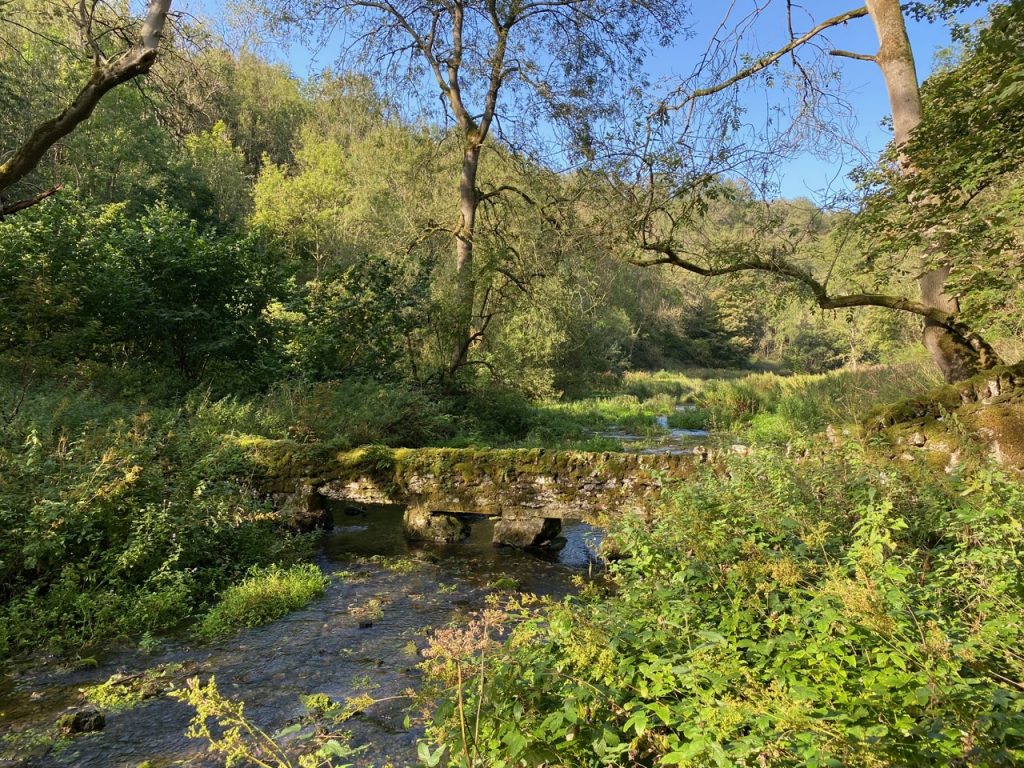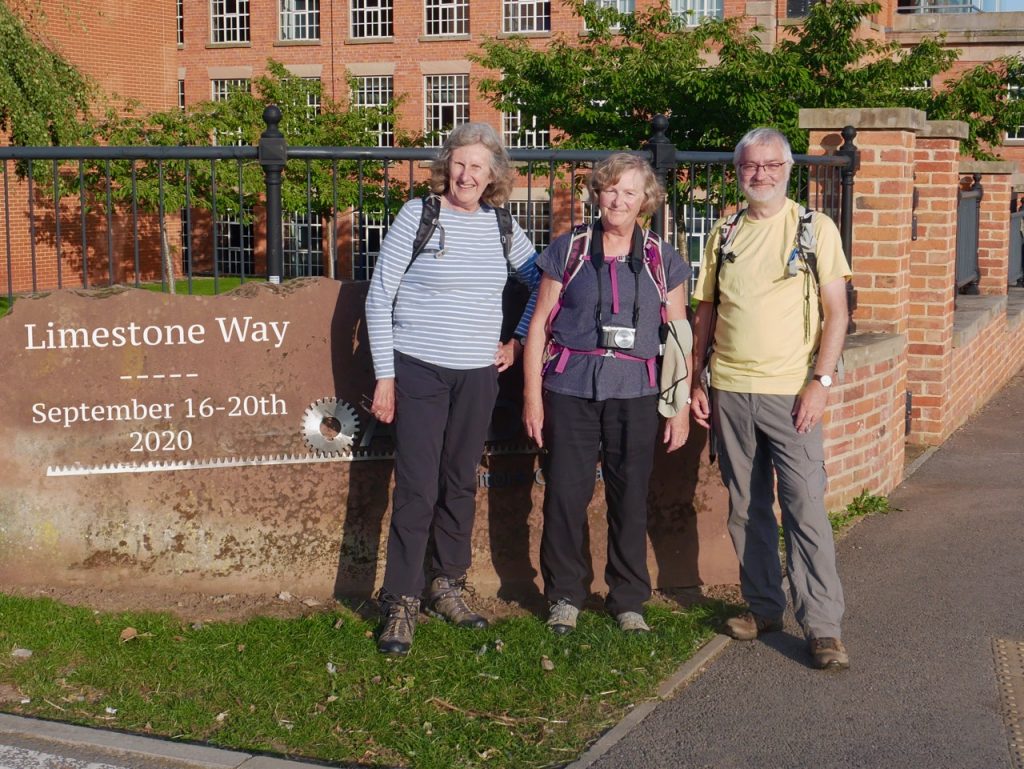The white limestone rocks of the dales and drystone walls are the remains of a vast tropically warm sea of the Carboniferous period some 330 million years ago. Here, by water and other natural forces, the overlying gritstones and shales have worn away to expose rocks which are the remains of countless millions of tiny creatures which lived in that ocean. These limestone uplands and dales were among the first places to be settled by man and they are rich in prehistoric remains. Today most of the meadowland, except in the gorge-like dales, has been improved for livestock rearing and the sight of herds of black and white dairy cattle is typical of the area.
Limestone Way Walker’s Guide, 2007
– a pedestrians paradise, hitherto innocent of the locomotive’s voice, but now to be opened up for mineral traffic, and for rambles by many a worker in forge, factory, and mill, who knows how to wisely spend his ‘half-holiday’
John Pendleton, from A History of Derbyshire, 1886
A waymarked trail across the limestone plateau of Derbyshire’s White Peak, from Castleton, at the head of the Hope Valley, to Rocester, by the River Dove in Staffordshire. The route covers 46 miles (74 km).
We split the walk over five consecutive days: drow ‘n smirr on the first, glorious weather for the rest!
Section 1: Castleton to the A6
10.48 miles 5h 26m 548m ascent
The wild section.
Section 2: A6 to Youlgreave
10.01 miles 6h 6m 226m ascent
The pretty section
Section 3: Youlgreave to Grangemill
9.13 miles 6h 19m 378m ascent
The ancient times section
Section 4: Grangemill to Thorpe
9.35 miles 6h 44m 376m ascent
The fields and gaps section
Section 5: Thorpe to Rocester
10.13 miles 6h 58m 274m ascent
The Staffordshire section
Maps and Guides: Derbyshire Dales District Council have produced an excellent Limestone Way Walker’s Guide. I spent £3.70 on a hard copy but with a little effort it can be downloaded for free. I would not rely on the guide alone. Nor for that matter can you rely solely on the waymarkers and signposts. We took along OS 1:25k maps. OL1, OL24 and 259 cover the full trail. They are too big to be opened when walking and are printed on both sides of their paper so have to be refolded during a day’s walk. I find it irritating turning a huge map inside-out during a walk but I suppose I’m stuck with it until I convert to using OS maps on my phone.
Broken bits: We found some stiles broken, some wobbly and some overgrown. There were several poorly insulated electric fences to cross and we were sometimes faced with fields containing cows and calves. Some waymarker posts and signposts had fallen over. I think much of this could be down to limited maintenance and reduced use during the recent lockdowns.
Terrain etc.: The trail’s official distance is 46 miles, and our GPS measured distance (once we had stripped out the off-trail walking) was pretty close at 47.7 miles. There is not any particularly difficult terrain and I found it a nice change to walk over well drained land. Under normal circumstances the route would have lent itself to pub-lunches, but pandemic considerations meant we took sandwiches. The dogs didn’t come on this walk but: there were plenty of stiles to cross and only one with a dog run; dogs would need help with many of the squeeze gaps; lots of livestock (often close up); and there is not much water lying about.
Limestone Way: September 2020
And no walk would be complete without a spot of local verse…
THE PARSON'S TORR The parson of Monyash, late one eve, Sat in his old oak armchair; And a playful flame in the low turf fire Ofttimes shewed him sitting there. What was it that made the kind-hearted man Sit pensively there alone? Did other men's sorrows make sad his heart, Or say — a glimpse of his own? Black dark was that night and stormy withal, It rained as 'twould rain a sea; And round and within the old parsonage-house The wind moaned piteously. 1 Still sat he deep musing till midnight hour, And then in a waking dream — He quailed to hear 'mid the tempest a crash, And eke a wild piercing scream. " Oh, mercy !" cried he, with faltering breath, " What sounds are these which I hear? May evil be far from both me and mine! Good Lord, be Thou to us near!" No longer sat he in the old armchair, But prayed and lay down in bed; And strove hard to sleep and not hear the storm That scowled and raged o'er his head. But sleep seldom comes when 'tis most desired — And least to a troubled mind; And the parson lay wake long time I ween Ere soft repose he could find. As the dark hours of night passed slowly on, He slept as weary man will; But light was his sleep and broken his rest, And sad his foredread of ill. Thus restless he lay, and at early dawn He dream'd that he fell amain, Down, down an abyss of fathomless depth, Loud shrieking for help in vain. He woke up at once with a sudden shock, And threw out his arms widespread; " Good heavens I" he gasped ; " what ill omen is this? Where am I ? — with quick or dead!" Right well was he pleased to find 'twas a dream — That still he was safe and sound; With the last shades of night fear passed away, And joy once more again came round. The morning was calm, and the storm was hushed, Nor wind nor rain swept the sky; And betimes he arose, for bound was he To Bakewell that day to hie. Old Hugh brought his horse to the garden gate, And saw him all safe astride; " Good-bye," quoth the parson ; quoth Hugh " Good-bye! I wish you a pleasant ride!" Forth rode he across the lone trackless moor, His thoughts on his errand bent, And hoped he right soon to come back again The very same way he went. The journey to Bakewell he safely made A little before midday; But vicar and people were all at church, Where they were oft wont to pray. I'll put up my beast," quoth the parson, "here At the White Horse hostelry' And go up to church, that when prayers are done The vicar I there may see." But ere he could reach the old Newark door Both priest and people were gone; And the vicar to soothe a dying man To Over Haddon sped on. Twas three past noon when the vicar came back, The parson he asked to dine; And time stole a march on the heedless guest — Six struck as he sat at his wine. Up rose he from table, and took his leave, Quite startled to find it late; He called for his horse at the hostelry, And homeward was soon agate. As he rode up the hill, past All Saint's Church, The moon just one glance bestowed, And the weird-like form of the old stone cross In the churchyard dimly showed. Still higher and higher he climbed the hill, Yet more and more dark it grew; The drizzling rain became sleet as he climbed, And the wind more keenly blew. Ah ! thick was the mist on the moor that night — Poor wight ! he had lost his way! The north-east wind blowing strong on his right, To the left had made him stray. And now he was close to lone Haddon Grove, Bewildered upon the moor; Slow leading his horse that followed behind, Himself groping on before. Still onward and leeward, at last he came To the edge of Harlow Dale; From his cave Lathkil a warning roared, But louder then howled the gale. On the brink of Fox Torr the doomed man stood, And tugged the bridle in vain; But his horse would not move; then quick started back, And snap went each bridle rein! Then headlong fell he o'er the lofty cliff: He shrieked and sank in the gloom; Down, down to the bottom he swiftly sped, And death was his dreadful doom. The dead man lay cold on the blood-stained rocks — The darkness did him enshroud; And the owls high up in the ivy-clad Torr Bewailed him all night full loud. Oh, little they thought in the old thatched cot Hard by the parsonage gate, Their master they never again should see, Nor ope to him soon or late. " This night is no better than last," quoth Hugh, " And master has not come back; I hope he is hale, and safe housed with friends, And has of good cheer no lack." Quoth Betty, " I liked not his morning ride; I fear he's in evil plight; A Friday's venture's no luck, I've heard say — God help him if out this night!" At dawn of next day old Betty went forth To milk the cow in the shed, And saw him sitting upon a large stone, All pale and mute, with bare head! But a moment she turned her eyes away, A fall she heard and a groan; She looked again, but no parson was there — He'd vanished from off the stone! Soon spread the dread tale through Monyash town- They made a great hue and cry; And some off to this place and some to that To seek the lost man did hie. Bad tidings from Bakewell— no parson there — No parson could else be found; 'Twas noon, yet no tidings — they still searched on, And missed they no likely ground. At last the searchers went into the dale: And there at the foot of Fox Torr They found the parson, all cold and dead, 'Mong the rocks all stained with gore. They took up his corse, and six stalwart men Slowly bore it along the dale; And they laid the dead in his house that night, And many did him bewail. When time had passed over — a day or twain, They buried him in the grave; And his bones now rest in the lone churchyard Till doomsday them thence shall crave. Oh, dread was the death of the luckless man, Not soon will it be forgot; The dismal story, for ages to come, Will often be told, I wot. You may not now see in Monyash town The dead man's sear tuft of grass; But still it is there in memory stored, And thence it never shall pass. You may not now find Fox Torr by that name — The swain thus knows it no more; But pointing thereat from Latkil grot, He'll show you the Parson's Torr.' Rev. W. R. Bell The "Parson's Torr" describes of the fate of the Rev. Robert Lomas, a former rector of Monyash. During a perilous night-ride in 1776 he fell over a lofty cliff and was found dead at the foot of the rock.

